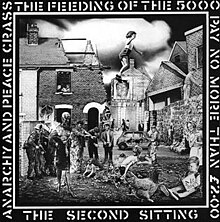The Feeding of the 5000 (album)
| The Feeding of the 5000 | ||||
|---|---|---|---|---|
 |
||||
| Studio album by Crass | ||||
| Released | February 1979 | |||
| Recorded | 29 October 1978 | |||
| Genre | Anarcho-punk | |||
| Length | 31:50 | |||
| Label | Crass Records | |||
| Producer | Crass | |||
| Crass chronology | ||||
|
||||
| Alternative covers | ||||

Cover of the remastered 'Crassical Collection' rerelease
|
||||
| Professional ratings | |
|---|---|
| Review scores | |
| Source | Rating |
| AllMusic | |
The Feeding of the 5000 is the first album by the anarcho-punk band Crass. The album was recorded on October 29, 1978, by John Loder at Southern Studios and was released the same year. It was considered revolutionary in its time due to what was considered an extreme sound, frequently profane lyrical content and the anarchist political ideals in the lyrics. The album also saw the introduction of Crass's policy of ensuring cheap prices for their records. This album is considered one of the first punk albums to expound serious anarchist philosophies.
The record was made when Pete Stennett, owner of Small Wonder Records, heard a demo that the band had recorded. Impressed by all of the material, he decided that rather than release a conventional single by the band, he would put all of their set onto an 18-track 12" EP. However, problems were encountered when workers at the Irish pressing plant contracted to manufacture the record refused to handle it due to the allegedly blasphemous content of the track "Reality Asylum" (referred to as "Asylum" on the record sleeve). The record was eventually released with this track removed and replaced by two minutes of silence, retitled "The Sound of Free Speech". This incident also prompted Crass to set up their own record label in order to retain full editorial control over their material, and "Reality Asylum" was issued shortly afterwards in a re-recorded and extended form as a 7" single. A later repress of The Feeding of The 5000 (subtitled The Second Sitting) released on Crass records in 1980 restored the missing track.
Crass helped reinitiate the influence of the Campaign for Nuclear Disarmament and the wider peace campaign in the UK with the songs like "They've Got a Bomb", "Fight War Not Wars" and the adoption of the CND Symbol at their live concerts.
"They've got a Bomb" also has a period of silence within it, inspired by John Cage's "4'33"". The band have acknowledged the influence of Cage, and said that the idea of the space in the song, when performed live, was to suddenly stop the energy, dancing and noise and allow the audience to momentarily "confront themselves" and consider the reality of nuclear war.
...
Wikipedia
